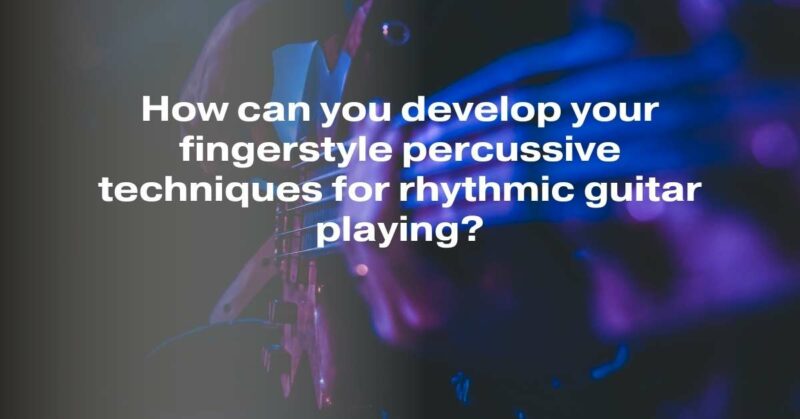The art of fingerstyle guitar playing is a mesmerizing combination of melody, harmony, and rhythm. One of the most captivating facets of this style is the incorporation of percussive elements into your playing, which can add depth, dynamics, and an irresistible groove to your music. In this article, we will explore how you can develop your fingerstyle percussive techniques for rhythmic guitar playing.
1. Understand the Basics of Fingerstyle Playing
Before diving into percussive techniques, it’s crucial to have a solid foundation in fingerstyle guitar playing. Start by practicing fingerpicking patterns and familiarizing yourself with the finger positions and movements. Build up your finger strength and dexterity, as these skills will serve as the bedrock for adding percussive elements to your playing.
2. Explore Thumb Slaps and Palm Muting
Thumb slaps and palm muting are fundamental percussive techniques in fingerstyle guitar. The thumb slap involves striking the strings with the thumb while maintaining a muted or percussive sound. Experiment with different thumb-slapping positions and rhythms to create unique grooves.
Palm muting, on the other hand, involves lightly resting the palm of your hand on the strings near the bridge while plucking with your fingers. This technique produces a muted and percussive tone that can be used to add rhythmic depth to your playing.
3. Incorporate Percussive Taps and Finger Snaps
Percussive taps and finger snaps are effective ways to infuse your playing with rhythmic flair. Tapping involves using your fingers to gently tap the body of the guitar while playing, creating a percussive sound. This technique can be used to simulate drum beats or accentuate specific rhythmic patterns.
Finger snaps can be integrated into your playing by simply snapping your fingers while picking or strumming. The snap sound can be synchronized with your music to add a unique percussive element that complements the rhythm.
4. Develop Hybrid Picking Techniques
Hybrid picking combines fingerstyle and flat-picking techniques. By using a pick in conjunction with your fingers, you can achieve a wider range of percussive possibilities. Experiment with pick slaps, where you strike the strings with the edge of the pick, and combine them with fingerpicking patterns to create intricate rhythmic textures.
5. Explore the Use of Harmonics
Harmonics are a beautiful addition to percussive fingerstyle guitar playing. By lightly touching the strings at specific points while plucking them, you can produce harmonic overtones that add an ethereal and percussive quality to your music. Experiment with natural and artificial harmonics to create unique rhythmic effects.
6. Practice Rhythmic Independence
To become proficient in percussive fingerstyle guitar playing, it’s essential to develop rhythmic independence between your fingers and percussive elements. This involves ensuring that your fingers continue to play the melody or chords smoothly while incorporating percussive techniques seamlessly. Practicing with a metronome and gradually increasing the tempo can help you master this skill.
7. Study the Work of Fingerstyle Masters
Learning from experienced fingerstyle guitarists can be incredibly inspiring and educational. Listen to the work of artists like Tommy Emmanuel, Andy McKee, and Michael Hedges, who have mastered percussive fingerstyle techniques. Study their techniques and try to incorporate elements of their style into your own playing.
Conclusion
Developing your fingerstyle percussive techniques for rhythmic guitar playing is a rewarding journey that can elevate your musicality to new heights. Remember that patience and consistent practice are key to mastering these techniques. By combining the fundamentals of fingerstyle guitar with creative percussive elements, you can create captivating rhythms that make your music truly unforgettable. So, pick up your guitar, start experimenting, and let your rhythmic creativity flow.

